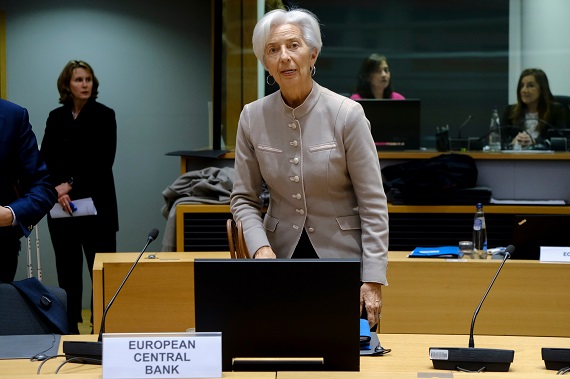By David McHugh AP Business Writer economy news bulletin news
Frankfurt, Germany (AP) — The European Central Bank cut its key interest rate Thursday by a quarter-point, moving ahead of the U.S. Federal Reserve as central banks around the world lean toward lowering borrowing costs — a shift with far-reaching consequences for home buyers, savers and investors.
The ECB cut its benchmark rate to 3.75% from a record high of 4% at a meeting of the bank’s 26-member rate-setting council in Frankfurt.
Speaking afterward at a news conference, ECB President Christine Lagarde said inflation had eased enough for the central bank to start lowering rates.
But with annual inflation at 2.6% in May and expected to remain above the ECB 2% target into next year, Lagarde declined to indicate how fast or how deep any future rate cuts might be.
“We will keep policy rates sufficiently restrictive for as long as necessary,” she said. “We are not committing to a particular rate path.”
economy news bulletin news
“Are we today moving into a dialing-back phase? I wouldn’t volunteer that,” she said.
Rate increases combat inflation by making it more expensive to borrow in order to buy goods, lowering demand and taking the pressure off prices. But high rates also hold back growth, which has been in short supply in the eurozone.
With inflation coming down but taking its time to reach levels central bankers like, the question now is, how soon, how fast and how deep future rate cuts from the Fed, the ECB and others will be.
Analysts say the ECB will likely leave rates unchanged when it next meets on July 18, while it awaits further confirmation that inflation is under control.
“Today’s cut doesn’t necessarily mark the start of an easing cycle,” said Carsten Brzeski, global head of macro at ING, the Dutch banking firm.
(Please click onto the image of the cat to hear Classical Music)

Though the annual inflation rate for May is well below a peak of 10.6% in October 2022, the decline has slowed in recent months. Inflation even ticked up slightly from 2.4% in April. Inflation in the services sectors, a broad category that includes everything from medical care and haircuts to hotels, restaurants and concert tickets, remains particularly elevated at 4.1%.
economy news bulletin news
The ECB’s move represents a switch from the onset of the inflation surge, when the Fed took the lead in tightening credit by raising rates starting in March 2022, sending mortgage costs higher but also boosting returns for savers with money in certificates of deposit or money market funds. The ECB started four months later.
Major central banks around the world now are leaning toward lowering interest rates. Central banks in smaller economies have already cut rates, including in Canada, Sweden, Switzerland, Hungary and the Czech Republic. The Bank of England’s policymakers are scheduled to meet on June 20, but it’s not clear whether the governing board will cut the rate from 5.25%. Japan, an economic outlier among the world big economies, has started raising rates after years of below-zero rates and low inflation.
Lower rates can mean lower mortgage costs and credit card charges for consumers. Lower rates also can boost stock prices and the value of retirement accounts since they diminish returns on conservative alternatives such as certificates of deposit and can mean stronger economic growth that will boost corporate earnings.
The ECB’s higher rates quashed a nine-year-long rally in eurozone home prices and slammed construction activity. Growth in economic output has hovered just above and below zero for more than a year before a modest upbeat surprise in the first three months of the year, when gross domestic product rose 0.3% from the quarter before.
economy news bulletin news
The inflation surge in Europe was unleashed first and foremost by Russia cutting off most natural gas supplies to the continent, and by logjams in supplies of raw materials and parts as the global economy rebounded from the COVID-19 pandemic. Although the eurozone was hit first and hardest by the Russian cutoff, the resulting energy price spike has now largely subsided after spiking to 10.6% in October 2022.
The Federal Reserve faces a very different economy, one in which inflation was fueled less by the Russian energy shock than by government pandemic recovery spending, and more robust growth fueled inflation. The U.S. consumer price index is at an annual 3.4%, some way from the Fed’s goal, also 2%.
Fed Chair Jerome Powell has said the bank expects to cut rates this year from the current benchmark level of 5.25%-5.5%, but no change is expected at the Fed’s policy meeting next week. With inflation cooling slowly in the U.S., economists and investors now increasingly expect only one or two cuts this year.
AP Economics Writer Christopher Rugaber contributed to this report from Washington.
Notes from APS Radio News
Reportedly because of what was being called a “pandemic”, a number of the world’s central banks embarked on massive programs of monetary expansion, starting in late February and early March of 2020.
For its part, between the early part of March of 2020 to over a year later, the US Federal Reserve added over $4 trillion to its holdings, by purchasing billions of dollars’ worth of Treasury bonds and corporate bonds each month during that period.
economy news bulletin news
As well, at that time it kept interest rates rather low.
Other central banks, including the Bank of Japan and the European Central Bank, followed similar policies.
In addition, during that period many countries engaged in lockdowns; many small and medium-sized businesses and enterprises were shuttered by way of orders issued by public health officials, politicians and various administrators.
One of the direct causes of those shutdowns was the development of shortages.
According to a number of economists, the combination of shortages of various goods and services and massive programs of “quantitative easing” led to substantially higher rates of inflation.
In consequence of shuttered economies and higher rates of inflation in the first world, less developed countries suffered greatly, due, in part, to shortages of supplies and due to lowered demand.
For some time, in its articles about China, The Wall Street Journal has pointed to “covid” related lockdowns as being one of the major causes of China’s downturn in its economy.
In the US, by October of 2020, over 100,000 businesses had been shuttered by way of lockdowns
economy news bulletin news


